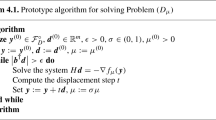Abstract
In this note we report a simple characteristic of linear programming central trajectories which has a surprising consequence. Specifically, we show that given a bounded polyhedral setP with nonempty interior, the logarithmic barrier function (with no objective component) induces a vector field of negative Newton directions which flows from the center ofP, along central trajectories, to solutions of every possible linear program onP.
Similar content being viewed by others
References
E.R. Barnes, “A variation on Karmarkar's algorithm for solving linear programming problems,”Mathematical Programming 36 (1986) 174–182.
E.R. Barnes, S. Chopra and D. Jensen, manuscript in preparation, IBM Watson Research Center (Yorktown Heights, NY, 1987).
D.A. Bayer and J.C. Lagarias, “The nonlinear geometry of linear programming I. Affine and projective scaling trajectories,” AT&T Bell Laboratories (Murray Hill, NJ, 1986).
D.A. Bayer and J.C. Lagarias, “The nonlinear geometry of linear programming II. Legendre transform coordinates,” AT&T Bell Laboratories (Murray Hill, NJ, 1986).
D.A. Bayer and J.C. Lagarias, “The nonlinear geometry of linear programming III. Central trajectories,” AT&T Bell Laboratories (Murray Hill, NJ, 1986).
P.E. Gill, W. Murray, M.A. Saunders, J.A. Tomlin and M.H. Wright, “On projected Newton barrier methods for linear programming and an equivalence to Karmarkar's projective method,”Mathematical Programming 36 (1986) 183–209.
C.C. Gonzaga, “An algorithm for solving linear programming problems in O(n 3 L) operations,” Memorandum UCB/ERL M87/10, University of California (Berkeley, CA, 1987).
N. Karmarkar, “A new polynomial-time algorithm for linear programming,”Combinatorica 4 (1984) 373–395.
J.C. Lagarias, private communication (1986).
N. Megiddo, “Pathways to the optimal set in linear programming,” Research Report RJ 5295, IBM Almaden Research Center (San Jose, CA, 1986).
N. Megiddo and M. Shub, “Boundary behavior of interior point algorithms in linear programming,” Research report RJ 5319, IBM Watson Research Center (Yorktown Heights, NY, 1986).
J. Renegar, “A polynomial-time algorithm, based on Newton's method, for linear programming,”Mathematical Programming 40 (1988) 59–93.
G. Sonnevend, “An analytical centre for a polyhedron and new classes of global algorithms for linear (smooth, convex) programming,” in:Proceedings of the 12th IFIP Conference on System Modeling (Budapest, 1985).
P.M. Vaidya, “An algorithm for linear programming which requires O(((m+n)n 2+(m+n)1.5 n)L) arithmetic operations,” AT&T Bell Laboratories (Murray Hill, NJ, 1987).
R.J. Vanderbei, M.J. Meketon and B.A. Freedman, “A modification of Karmarkar's linear programming algorithm,”Algorithmica 1 (1986) 395–407.
Author information
Authors and Affiliations
Rights and permissions
About this article
Cite this article
Anstreicher, K.M. Linear programming and the newton barrier flow. Mathematical Programming 41, 367–373 (1988). https://doi.org/10.1007/BF01580774
Received:
Revised:
Issue Date:
DOI: https://doi.org/10.1007/BF01580774




